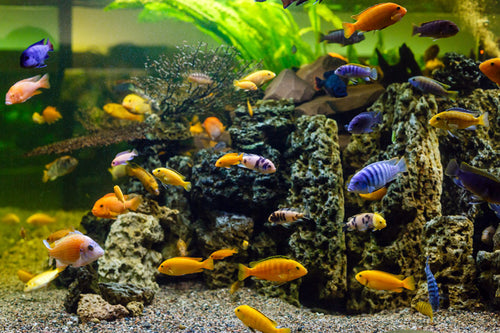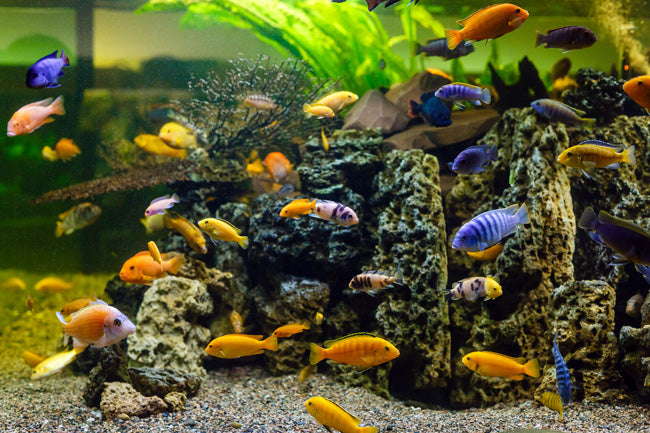Mixed Malawi Cichlids - 2-5cm
Mixed Malawi Cichlids - 2-5cm
check_circle Fast Shipping
check_circle Quality Products
check_circle Affordable Price
Reach out to us on ''available to order'' items via WhatsApp or email
11 in stock
Couldn't load pickup availability

Mixed Malawi Cichlids - 2-5cm
package_2
Product Description
Product Description
All our fish, shrimp and corals are bagged with fresh oxygen as well as a heat pack in winter.
When ordering livestock please select the box size and add it to your cart for accurate overnight (1-2 days) shipping costs. A small box can take 1-2 bags and a medium box 6 bags. One bag fits max 10 small (1-3cm) fish or max 2 medium (3-5cm) fish or max 1 large (>5cm) fish.
ONE SPECIES PER BAG. Eg: One bag of 10 neon tetra.
Malawi Cichlid
Malawi Cichlids are a diverse group of cichlids native to Lake Malawi in Africa. They come in various species and color morphs, but many share similar care requirements. Below is a general description and care guide for Malawi Cichlids:
Description:
-
Appearance:
- Body: Generally robust and elongated with a laterally compressed shape. The size, coloration, and markings can vary widely among species.
- Color: Bright and vivid colors, including blues, yellows, reds, and greens. Some species have distinctive patterns, such as stripes or spots.
- Fins: Fins are usually elongated and well-developed, adding to their striking appearance.
- Size: Typically ranges from 4 to 8 inches (10-20 cm) for many species, but some can grow larger.
-
Behavior:
- Activity: Active and territorial, often displaying vibrant colors during territorial disputes or courtship.
- Social Structure: Many species are territorial and may show aggression towards other fish, especially of the same species or similar appearance.
Care Requirements:
-
Tank Size:
- Minimum: 55 gallons (208 liters). Larger tanks are preferable to provide ample swimming space and reduce territorial aggression.
-
Water Parameters:
- Temperature: 75-82°F (24-28°C). They thrive in warm water similar to their native lake environment.
- pH: 7.5-8.5. They prefer alkaline water conditions.
- Hardness: 10-20 dGH (degrees of general hardness). They thrive in hard water, mimicking their natural lake habitat.
- Filtration: Strong filtration is essential to maintain water quality and mimic the clean, well-oxygenated conditions of Lake Malawi.
-
Tank Setup:
- Substrate: Coarse sand or gravel. They often sift through the substrate in search of food.
- Aquascaping: Provide plenty of rocks and caves to create territories and hiding spots. Malawi Cichlids appreciate a rocky environment with open swimming areas.
- Lighting: Moderate to bright lighting. They are not particularly sensitive to lighting but a well-lit tank can enhance their colors.
-
Diet:
- Primary Food: Omnivorous. They eat a variety of foods including high-quality pellets, flakes, and live or frozen foods such as brine shrimp, bloodworms, and daphnia.
- Supplemental Food: Offer occasional treats like spirulina-based foods and blanched vegetables. A varied diet helps maintain their vibrant coloration and overall health.
-
Behavioral Considerations:
- Compatibility: Avoid keeping with very aggressive or very small fish. Many Malawi Cichlids are best kept in species-specific tanks or with other similarly sized and similarly aggressive species.
- Social Behavior: Some species are more social than others and can be kept in groups, while others may prefer to be kept singly or in pairs.
-
Tank Maintenance:
- Water Changes: Regular water changes (20-30% weekly) are crucial to maintain water quality and remove waste.
- Cleaning: Clean the tank, including the substrate and filter, regularly to prevent the buildup of organic matter.
-
Health Care:
- Observation: Monitor for signs of stress or illness, such as changes in behavior, loss of appetite, or visible symptoms like discoloration or lesions.
- Treatment: Maintain optimal water conditions and consult an aquarium professional if health issues arise. Common problems include fin rot, mouth fungus, and internal parasites.


